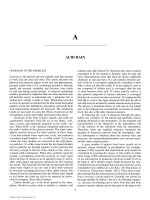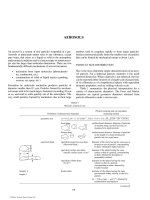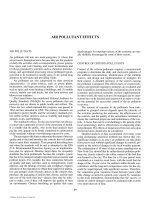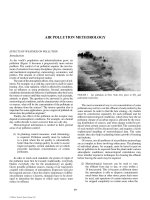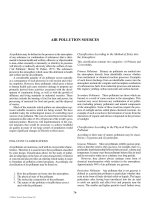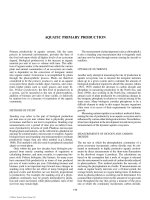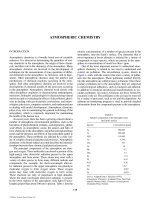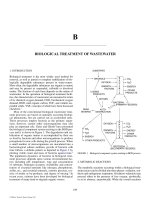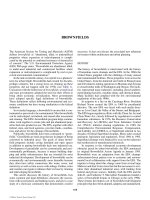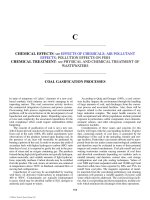ENCYCLOPEDIA OF ENVIRONMENTAL SCIENCE AND ENGINEERING - NATURAL SYSTEMS FOR WASTEWATER TREATMENT pdf
Bạn đang xem bản rút gọn của tài liệu. Xem và tải ngay bản đầy đủ của tài liệu tại đây (499.3 KB, 9 trang )
737
N
NATURAL SYSTEMS FOR WASTEWATER TREATMENT
INTRODUCTION
In the continual search for a simple, reliable, and inexpen-
sive wastewater treatment system, the natural systems are the
latest discovery. They provide not only efficient methods of
wastewater treatment, but also provide some indirect benefi-
cial uses of the facility such as green space, wildlife habitat,
and recreational areas.
In the natural environment, physical, chemical, and bio-
logical processes occur when water, soils, plants, microor-
ganisms, and atmosphere interact. To utilize these processes,
natural systems are designed. The processes involved in the
natural systems include: sedimentation, filtration, gas transfer,
adsorption, ion exchange, chemical precipitation, chemical
oxidation and reduction, and biological conversions plus other
unique processes such as photosynthesis, photooxidation,
and aquatic plant uptake.
1
In natural systems, the processes
occur at “natural” rates and tend to occur simultaneously in
a single “ecosystem reactor” as opposed to mechanical sys-
tems in which processes occur sequentially in separate reac-
tors or tanks in accelerated rates as a result of energy input.
Generally, a natural system might typically include pumps
and piping for wastewater conveyance but would not depend
on external energy sources exclusively to maintain the major
treatment responses.
2
In this paper a general overview of natural systems for
wastewater treatment is presented. The constructed wet-
lands are becoming a viable wastewater treatment alterna-
tive for small communities, individual homes, and rest areas.
Therefore, in this paper, a great deal of information has been
presented on site selection, design of physical facilities, per-
formance expectations, hydraulic and organic loading rates,
and cost of the constructed wetlands.
TYPES OF NATURAL SYSTEMS
Natural systems for effective wastewater treatment are
divided into two major types: terrestrial, and aquatic systems.
Both systems depend on physical and chemical responses as
well as on the unique biological components.
2
Each of these
systems are discussed below.
Terrestrial Treatment Systems
Land application is the sole terrestrial treatment system used
to remove various constituents from the wastewater. It uti-
lizes natural physical, chemical, and biological processes
within the soil-plant-water matrix. The objectives of the land
treatment system includes, irrigation, nutrient reuse, crop
production, recharge of ground water and water reclamation
for reuse. There are three basic methods of land application:
(1) Slow-rate irrigation, (2) Rapid-infiltration–percolation,
and (3) Overland flow. Each method can produce renovated
water of different quality, can be adapted to different site
conditions, and can satisfy different overall objectives.
3,4
Typical design features and performance expectations for
Slow-rate irrigation Irrigation is the most widely used form
of land treatment systems. It requires presence of vegetation
as a major treatment component. The wastewater is applied
either by sprinkling or by surface technologies. In this pro-
cess surface runoff is not allowed. A large portion of water is
lost by evapotranspiration whereas some water may reach the
groundwater table. Groundwater quality criteria may be a lim-
iting factor for the selection of the system. Some factors that
are given consideration in design and selection of irrigation
method are (1) availability of suitable site, (2) type of waste-
water and pretreatment, (3) climatic conditions and storage
needed, (4) soil type, and organic and hydraulic loading rates,
(5) crop production, (6) distribution methods, (7) application
cycle, and (8) ground and surface water pollution.
2,3,5
Rapid-infiltration – percolation In rapid-infiltration-percolation
the wastewater percolates through the soil and treated effluent
reaches the groundwater or underdrain systems. Plants are
not used for evapotranspiration as in irrigation system. The
objectives of rapid infiltration—percolation are (1) ground-
water recharge, (2) natural treatment followed by withdrawal
C014_001_r03.indd 737C014_001_r03.indd 737 11/18/2005 10:44:16 AM11/18/2005 10:44:16 AM
© 2006 by Taylor & Francis Group, LLC
the three basic terrestrial concepts are given in Table 1.
738 NATURAL SYSTEMS FOR WASTEWATER TREATMENT
by pumping or under-drain systems for recovery of treated
water, (3) natural treatment with groundwater moving verti-
cally and laterally in the soil, and (4) recharging a surface water
source.
5
Overland flow In the overland flow system, the wastewater
is applied over the upper reaches of the sloped terraces and
allowed to flow overland and is collected at the toe of the slopes.
The collected effluent can be either reused or discharged into
a receiving water. Biochemical oxidation, sedimentation, fil-
tration and chemical adsorption are the primary mechanisms
for removal of the contaminants. Nitrogen removal is achieved
through denitrification. Plant uptake of nitrogen and phospho-
rus are significant if crop harvesting is practiced.
3,5
Aquatic Treatment Systems
Aquatic system utilize lagoons and ponds, and wetlands. The
lagoons and ponds depend on microbial life, and lower plants
and animals, while wetlands support the growth of rooted
plants. Both pond systems and wetlands are discussed below.
Pond Systems
Within the aquatic systems, pond systems are the most widely
accepted ones. Basically pond systems can be of three types
based on oxygen requirement. These are aerobic, anaerobic
and facultative pond systems. In all cases the major treatment
responses are due to the biological components.
2,7
In most of
the pond systems both performance and final water quality are
dependent on the algae present in the system. Algae are func-
tionally beneficial, providing oxygen to support other biologi-
cal responses, and the algae-carbonate reactions are the basis
for the effective nitrogen removal in the ponds. However,
algae can be difficult to remove from the effluent. As a result,
the stringent limits for suspended solids in the effluent can not
be met. The design features and performance expectations for
Aerobic ponds Aerobic ponds, also called high rate aero-
bic ponds, maintain dissolved oxygen (DO) throughout their
entire depth. They are usually 30 to 45 cm deep, allowing
light to penetrate to the full depth.
3
Mixing is often pro-
vided to expose all algae to sunlight and to avoid deposi-
tion. As a result, formation of anaerobic sludge layer can be
reduced. Oxygen is provided by photosynthesis and surface
reaeration. Because of the presence of sufficient dissolved
oxygen, aerobic bacteria can stabilize the waste. Detention
time is short, usually 3 to 5 days. Aerobic ponds are lim-
ited to warm sunny climate and are used infrequently in the
United States.
2,7
TABLE 1
Design features and expected performance for terrestrial treatment units
Typical criteria
Concepts Treatment goals Climate needs Vegetation Area,
b
ha
Organic loading,
kg BOD
5
/ha.d
Hydraulic
loading, m/year
Effluent
characteristics, mg/L
Slow rate Secondary, or AWT
a
Warmer season Yes 23–280 — 0.5–6 BOD Ͻ2
TSS Ͻ1
TN Ͻ3
c
TP Ͻ0.1
c
FC 0
d
Rapid infiltration Secondary, or AWT,
or groundwater
recharge
None No 3–23 45–180 6–125 BOD 5
TSS 2
TN 10
TP Ͻ1
e
FC 10
Overland flow Secondary, nitrogen
removal
Warmer season Yes 6–40 Ͻ95 3–20 BOD 10
TSS 10
f
TN Ͻ10
TP Ͻ6
a
Advanced wastewater treatment.
b
For design flow of 3800 m
3
/d.
c
Total nitrogen removal depends on type of crop and management.
d
FC ϭ Fecal coliform, number per 100 ml.
e
Measured in immediate vicinity of basin, increased removal with longer travel distance.
f
Total suspended solids depends in part on type of wastewater applied.
Source: Adopted in part from Refs. 2, 3, 5, and 6.
C014_001_r03.indd 738C014_001_r03.indd 738 11/18/2005 10:44:16 AM11/18/2005 10:44:16 AM
© 2006 by Taylor & Francis Group, LLC
natural aquatic treatment units are summarized in Table 2.
NATURAL SYSTEMS FOR WASTEWATER TREATMENT 739
Anaerobic ponds Anaerobic ponds receive such a heavy
organic loading that there is no aerobic zone. They are
usually 2.5 to 5 m in depth and have detention time of 20 to
50 days.
2,3
The principal biological reactions occurring are
acid formation and methane production. Anaerobic ponds
are usually used for treatment of strong industrial and agri-
cultural wastes, or as a pretreatment step where an industry
is a significant contributor to a municipal system. They do
not have wide application to the treatment of municipal
wastewater.
Facultative ponds It is the most common type of pond
unit. These ponds are usually 1.2 to 2.5 m (4 to 8 ft) in
depth with an aerobic layer overlaying an anaerobic layer,
which often contains sludge deposits. The usual detention
time is 5 to 30 days.
2
Anaerobic fermentation occurs in the
lower layer, and aerobic stabilization occurs in the upper
layer. The key to facultative operation is oxygen produc-
tion by photosynthetic algae and surface reaeration. The
algae cells are necessary for oxygen production, but their
presence in the final effluent represents one of the most
serious performance problems associated with the facultative
ponds.
7
Wetland Treatment Systems
The wetlands are inundated land areas in which water table
is at or above the ground surface (usually 0.6 m or more).
This water table stands long enough time each year to main-
tain saturated soil conditions and also to support the growth
of related vegetation. The vegetation provides surface for
attachment of bacteria films, and aids in the filtration and
adsorption of wastewater constituents. Vegetation also trans-
locate oxygen from leaves to the root systems to support a
wide range of aerobic and facultative bacteria and controls
the growth of algae by restricting the penetration of sunlight.
9
The unique ability of wetland plants to translocate oxygen to
support a wide range of bacteria in the wetlands is shown
and constructed wetlands. Both natural and constructed wet-
lands have been used for wastewater treatment, although the
use of natural wetlands is generally limited to the polishing
or further treatment of secondary or advanced wastewater
treated effluent.
2
Natural wetlands From a regulatory standpoint, natural
wetlands are usually considered as part of the receiving
waters. Consequently discharges to natural wetlands, in most
cases, must meet applicable regulatory requirements, which
typically stipulate secondary or advanced wastewater treat-
ment.
10
Furthermore, the principal objective when discharg-
ing to natural wetlands should be enhancement of existing
habitat. Modification of existing wetlands to improve treat-
ment capability is often very disruptive to the natural ecosys-
tem and, in general, should not be attempted.
10,11
Constructed wetlands Constructed wetlands offer all of
the treatment capabilities of the natural wetlands but with-
out the constraints associated with discharging to a natural
ecosystem. Additionally, the constructed wetland treatment
units are not restricted to the special requirements on influ-
ent quality. They can ensure much more reliable control
over the hydraulic regime in the system and therefore per-
form more reliably than the natural wetlands.
10
Two types
of constructed wetlands have been developed for wastewater
treatment (1) free water surface (FWS) systems, and (2) sub-
surface flow system (SF). The schematic flow diagrams of
eral description of both types of systems is provided below.
The basic design considerations such as (a) site selection,
(b) plants types, (c) physical facilities, (d) hydrologic fac-
tors, (e) organic loading factors, and (f) performance expec-
tations, that are presented under a separate section entitled
Basic Design Considerations of Constructed Wetlands.
Free water surface (FWS) wetlands The free water surface
wetlands typically consist of a basin or channels with some type
of barrier to prevent seepage, soil to support the root systems
TABLE 2
Design features and expected performance for pond treatment units
Parameter
Aerobic
(High Rate)
Aerobic–anaerobic
(Facultative) Anaerobic
Detention time, days 5–20 10–30 20–50
Water depth, m 0.3–1 1–2 2.5–5
BOD
5
loading, kg/ha.d 40–120 15–120 200–500
Soluble BOD
5
removal, percent 90–97 85–95 80–95
Overall BOD
5
removal, percent 40–80 70–90 60–90
Algae concentration, mg/L 100–200 20–80 0–5
Effluent TSS, mg/L 100–250
a
40–100
a
70–120
a
a
TSS is high because of algae. Effluent quality can be improved significantly if algae is
removed.
Source: Adopted in part from Refs. 3, 4 and 8.
C014_001_r03.indd 739C014_001_r03.indd 739 11/18/2005 10:44:16 AM11/18/2005 10:44:16 AM
© 2006 by Taylor & Francis Group, LLC
both types of system have been shown in Figure 2. A gen-
in Figure 1. Wetlands can be of two types: natural wetlands
740 NATURAL SYSTEMS FOR WASTEWATER TREATMENT
of the emergent vegetations, and water through the system at
a relatively shallow depth.
2,9
The water surface in FWS wet-
lands is exposed to the atmosphere, and the intended flow
path through the system is horizontal. Pretreated wastewater is
applied continuously to such systems, and treatment occurs as
the water flows slowly through the stems and roots of emergent
vegetation. Free water surface systems may also be designed
with the objective of creating new wildlife habitats or enhanc-
schematic flow diagram of free water surface wetlands.
Subsurface flow (SF) wetlands The subsurface flow wet-
lands also consist of a basin or channel with a barrier to pre-
vent seepage. The basin or channel is filled to a suitable depth
with a porous media. Rock or gravel are the most commonly
used media types. The media also supports the root systems of
the emergent vegetation. The design of these systems assumes
that the water level in the bed will remain below the top of the
rock or gravel media. The flow path through the operational
systems is usually horizontal.
12
The schematic flow diagram
of submerged flow wetlands is provided in Figure 2(b).
Comparing the two types of constructed wetland sys-
tems, the SF type of wetlands offer several advantages over
FWS type. If the water surface is maintained below the
media surface there is little risk of odors, public exposure,
or insect vectors. In addition, it is believed that the media
provides larger available surface area for attached growth
organisms. As a result, the treatment response may be faster,
and smaller surface area may be needed for the same waste-
water conditions.
2,10
Furthermore, the subsurface position of
the water, and the accumulated plant debris on the surface of
the SF bed, offer great thermal protection in cold climates
as compared to the FWS type.
14
The reported disadvantage
of the SF type system however, is clogging of the media
possible overflow.
Basic Design Considerations of
Constructed Wetlands
Constructed wetlands are relatively recent development,
and are gaining popularity for treatment of wastewater from
small communities, and residential and commercial areas. In
this section the basic design information and economics of
constructed wetlands are compared.
Site selection A constructed wetland can be constructed
almost anywhere. In selecting a site for a free water surface
wetland the underlying soil permeability must be consid-
ered. The most desirable soil permeability is 10E-6 to 10E-7
m/s.
10
Sandy clay and silty clay loams can be suitable when
compacted. Sandy soils are too permeable to support wetland
vegetation unless there is an impermeable restricting layer
in the soil profile that result in a perched high ground water
table. Highly permeable soils can be used for wastewater
flows by forming narrow trenches and lining the trench walls
and bottoms with clay or an artificial liner. In heavy clay
soils, addition of peat moss or top soil will improve soil per-
meability and accelerate initial plant growth.
Plants Although natural wetlands typically contain a wide
diversity of plant life, there is no need to attempt to reproduce
the natural diversity in a constructed wetland. Such attempts
in the past have shown that eventually cattails alone or in
combination with either reeds or bulrushes will dominate
FIGURE 1 An enlarged root hair of wetland plants.
C014_001_r03.indd 740C014_001_r03.indd 740 11/18/2005 10:44:17 AM11/18/2005 10:44:17 AM
© 2006 by Taylor & Francis Group, LLC
ing nearby existing natural wetlands. Figure 2(a) provides a
NATURAL SYSTEMS FOR WASTEWATER TREATMENT 741
in a wastewater system owing to the high nutrient levels.
2
The emergent plants most frequently found in the waste-
water wetlands include cattails, reeds, rushes, bulrushes and
sedges. Some of the major environmental requirements of
Physical facilities The constructed wetlands behave typ-
ically like a plug flow reactor. Constructed wetlands offer
significant potential for optimizing performance through
selection of proper system configuration, including aspect
ratios, compartmentalization, and location of alternate and
multiple discharge sites.
The aspect ratio, defined as the ratio of length to width,
typically varies from 4:1 to 10:1. However, based on research
data developed on experimental constructed wetlands, the
aspect ratios approaching 1:1 may be acceptable.
13
Several
alternative flow diagrams and configurations of constructed
Hydrologic factors The performance of the constructed wet-
lands system is dependent on the system hydrology as well as
many other factors such as precipitation, infiltration, evapotrans-
piration, hydraulic loading rate, and water depth. These factors
affect the removal of organics, nutrients, and trace elements
not only by altering the detention time but also by either con-
centrating or diluting the wastewater.
9,10
For a constructed
wetland, the water balance can be expressed by Eq. (1)
[d V /d t ] ϭ Q
i
− Q
e
ϩ P − ET (1)
where,
Q
i
ϭ influent wastewater flow, m
3
/d
Q
e
ϭ effluent wastewater flow, m
3
/d
P ϭ precipitation, m
3
/d
ET ϭ evapotranspiration, m
3
/d
[d V /d t ] ϭ change in volume of water per unit time, m
3
/d
t ϭ time, d
Influent
Lined Basin
Soil Media
Effluent
Water surface
Wetland Plants
Influent
Lined Basin
Soil Media
Effluent
Water surface
Wetland Plants
(a)
(b)
FIGURE 2 Schematic flow diagrams of constructed wetland systems, (a) Free water surface, (b) Subsurface flow.
13
C014_001_r03.indd 741C014_001_r03.indd 741 11/18/2005 10:44:18 AM11/18/2005 10:44:18 AM
© 2006 by Taylor & Francis Group, LLC
these plants are given in Table 3.
wetlands are provided in Figure 3.
742 NATURAL SYSTEMS FOR WASTEWATER TREATMENT
Inf. Effl.
Influent
Effluent
RecycleRecycle
Recycle
Inf.
Eff.
(a) (b)
(d)(c)
FIGURE 3 Alternate flow diagram and configurations of constructed wetlands: (a) Plug flow with recycle; (b) Step feed with recycle;
(c) Step feed in wrap around pond; (d) Peripheral feed with center drawoff.
TABLE 3
Emergent aquatic plants for constructed wetlands
Common name
(Scientific name)
Temperature, °C
Maximum salinity
tolerance, ppt
b
Optimum pHSurvival Desirable
a
Cattail
(Typha spp.)
10–30 12–24 30 4–10
Common reed
(Phragmites communis)
12–33 10–30 45 2–8
Rush
(Juncus spp.)
16–26 — 20 5–7.5
Bulrush
(Scirpus spp.)
16–27 — 20 4–9
Sedge
(Carex spp.)
14–32 — — 5–7.5
a
Temperature range for seed germination: roots and rhizomes can survive in frozen soils.
b
ppt ϭ parts per thousands.
Source: Adopted in part from Ref. 15.
C014_001_r03.indd 742C014_001_r03.indd 742 11/18/2005 10:44:18 AM11/18/2005 10:44:18 AM
© 2006 by Taylor & Francis Group, LLC
NATURAL SYSTEMS FOR WASTEWATER TREATMENT 743
Hydraulic loading rate for FWS system is closely tied
to the hydrologic factors and conditions specific to the
site. Typical hydraulic loading rate of 198 m
3
/d.ha (21,000
gpd/acre) is considered sufficient for optimum treatment
efficiency.
BOD
5
loading rates There are two goals for organic load
control in the constructed wetlands. The first is the provision
of carbon source for denitrifying bacteria. The second goal
is to prevent overloading of the oxygen transfer ability of the
emergent plants. High organic loading, if not properly dis-
tributed, will cause anaerobic conditions, and plants die off.
The maximum organic loading rate for both type of systems
(FWS and SF) should not exceed 112 kg BOD
5
/ha.d.
2,9,10
Performance expectations Constructed wetland systems
can significantly remove the biochemical oxygen demand
(BOD), total suspended solids (TSS), nitrogen and phos-
phorus, as well as metals, trace organics and pathogens The
basic treatment mechanisms include sedimentation, chemi-
cal precipitation, adsorption, microbial decomposition,
as well as uptake by vegetation. Removal of BOD
5
, TSS,
nitrogen, phosphorus, heavy metals and toxic organics have
been reported.
2,17
The performance of many well known con-
structed wetlands in terms of BOD
5
, TSS, ammonia nitrogen
Mosquito control and plant harvesting are the two opera-
tional considerations associated with constructed wetlands for
wastewater treatment. Mosquito problems may occur when
wetland treatment systems are overloaded organically and
anaerobic conditions develop. Biological control agents such
as mosquitofish ( Gambusia affins ) die either from oxygen
starvation or hydrogen sulfide toxicity, allowing mosquito
larvae to mature into adults. Strategies used to control mos-
quito populations include effective pretreatment to reduce
total organic loading; stepfeeding of the influent wastewater
stream with effective influent distribution and effluent recy-
cle; vegetation management; natural controls, principally
mosquitofish, in conjunction with the above techniques; and
application of approved and environmentally safe chemical
control agents.
The usefulness of plant harvesting in wetland treatment
systems depends on several factors, including climate, plant
species, and the specific wastewater objectives. Plant harvest-
ing can affect treatment performance of wetlands by altering
the effect that plants have on the aquatic environment.
Further, because harvesting reduces congestion at the water
surface, control of mosquito larvae using fish is enhanced. It
has been reported in the literature that a total of 29,000 kg/ha
dry weight of harvestable biomass of Phragmites shoots can
be harvested for single harvesting in a year. Higher yield is
achievable with multiple harvesting.
The BOD
5
, TSS, nitrogen and phosphorus removal effi-
ciencies of constructed wetlands are discussed below.
BOD
5
Removal in FWS wetlands In the free water surface
constructed wetlands the soluble BOD
5
removal is due to
microbial growth attached to plant root, stems, and leaf litter
that has fallen into the water. BOD
5
removal is generally
expressed by a first order reaction kinetic (Eq. 2).
2,3,10
[ C
e
/ C
o
] ϭ exp(− K
T
t ) (2)
where,
C
e
ϭ effluent BOD
5
, mg/L
C
o
ϭ influent BOD
5
, mg/L
K
T
ϭ reaction rate constant, d
−1
t ϭ hydraulic retention time, d.
BOD
5
Removal in SF wetlands The major oxygen source
for the subsurface components (soil, gravel, rock, and other
media, in trenches or beds) is the oxygen transmitted by the
vegetation to the root zone. In most cases, there is very little
direct atmospheric reaeration as water surface remains below
the surface of the media.
17
Removal of BOD
5
is expressed by
Equation (3). This is also a first order equation and can be
rearranged to calculate the area required for the subsurface
flow system.
log( C
e
/ C
o
) ϭ −[ A
s
K
t
d e]/ Q (3)
where,
C
e
ϭ effluent BOD
5
, mg/L
C
o
ϭ influent BOD
5
, mg/L
K
t
ϭ reaction rate constant, d
−1
Q ϭ flow rate through the system, m
3
/d
d ϭ depth of submergence, m
e ϭ porosity of the bed,
A
s
ϭ surface area of the system, m
2
.
Suspended solids removal Suspended solids removal is
very effective in both types of constructed wetlands. Most
of the removal occurs within few meters beyond the inlet.
Control dispersion of the inlet flow will enhance removal
near the inlet zone. Proper dispersion of solids can be
achieved by low inlet velocities, even cross sectional load-
ings, and uniform flow without stagnation.
10
Nitrogen removal Nitrogen removal is very effective in
both the free water surface and submerged flow constructed
wetlands, and the nitrification/denitrification is the major
path of nitrogen removal. Total nitrogen removals of up to
79 percent are reported at nitrogen loading rates of (based
on elemental N) up to 44 kg/(ha.day) [39 lb/(acre.day)], in a
variety of constructed wetlands. If plant harvesting is prac-
ticed, a higher rate of nitrogen removal can be expected.
9,20
Phosphorus removal Phosphorus removal in many wet-
lands is not very effective because of the limited contact
opportunities between the wastewater and the soil. The
exceptions are in the submerged bed design when proper
soils are selected as the medium for the system.
21
A signifi-
cant clay content and the presence of iron, and aluminum
will enhance the potential for phosphorus removal.
9,20,21
C014_001_r03.indd 743C014_001_r03.indd 743 11/18/2005 10:44:18 AM11/18/2005 10:44:18 AM
© 2006 by Taylor & Francis Group, LLC
and total phosphorus is summarized in Table 4.
744 NATURAL SYSTEMS FOR WASTEWATER TREATMENT
TABLE 4
Performances of some well known constructed wetlands
System name Location Type
Record
(years) Area (ha) Flow (m
3
/d)
BOD
5
(mg/L) TSS (mg/L) NH
3
-N (mg/L) TP (mg/L)
IN OUT IN OUT IN OUT IN OUT
Lakeland FL FWS 2 498 26978 3 2.5 4 3.5 0.90 0.36 9.46 4.07
Reedy Creek FL FWS 11.2 35.24 12058
5.3 1.9 8.9 2.4 2.98 0.72 1.4 1.78
Reedy Creek FL FWS 11.2 5.87 2423 5.8 1.6 10.9 2.4 3.29 0.12 1.8 0.79
Ironbridge FL FWS 1 486 34254 4.8 2.1 10.5 65.9 3.99 0.94 0.53 0.11
Apalachicola FL FWS 3 63.7 3936 15.2 1.1 107 8 3.62 0.09 3 0.21
Fort Deposit AL FWS 0.67 6 628 29.9 5.4 78.7 10.4 13.59 1 — —
West Jackson MS FWS 0.5 8.91 1953 21.6 10.5 65.9 24.5 2.69 0.19 5.13 3.56
Leaf River 1 MS FWS 1.2 0.13 225 15.8 14 54.8 30.1 9.91 7.21 8.91 8.16
Leaf River 2 MS FWS 1.2 0.13 254 15.8 15.7 54.8 34.9 9.91 6.33 8.91 8.19
Leaf River 3 MS FWS 1.2 0.13 220 15.8 13.9 54.8 25.5 9.91 6.79 8.91 5.9
Cobalt Canada FWS 1 0.10 49 20.7 4.6 36.2 28 2.95 1.04 1.68 0.77
Pembroke KY FWS 0.75 1.48 188 67.4 9.4 91.9 8.2 13.8 3.35 6.03 3.16
Central Slough SC FWS 4 32 5372 16.3 6.5 27.7 14.8 7.49 1.38 4.09 1.46
Gustine 1A CA FWS 1 0.39 163 130 49.8 73.5 39.6 17.4 16.1 — —
Gustin 2A CA FWS 1 0.39 174 151 44.8 99.8 33.8 18 23.2 — —
Philips School AL SFS 2 0.20 58.7 15.3 1 63.7 2 11 1.7 6 0.3
Kingston TN SFS 0.7 0.93 76 56 9 83 3 22 16 3.4 2.1
Denham Sprg. LA SFS 1.5 2.10 2548 28.2 10.5 53 17 11 4.33 — —
Monterey VA SFS 1.1 0.023 83 38 15 32 7 9.33 8.67 — —
Source: Adopted in part from Ref. 13.
C014_001_r03.indd 744C014_001_r03.indd 744 11/18/2005 10:44:18 AM11/18/2005 10:44:18 AM
© 2006 by Taylor & Francis Group, LLC
NATURAL SYSTEMS FOR WASTEWATER TREATMENT 745
Cost Cost is often a significant factor in selecting the type of
treatment system for a particular application. Unfortunately,
the availability of reliable cost data for wetland treatment
systems is limited. The cost of wetland treatment systems
varies depending on wastewater characteristics, the type of
wetland system, and the type of bottom preparation required.
Subsurface flow systems are generally more expensive
than free water surface systems. It has been reported that
the Tennesee Valley Authority (TVA) wetland construc-
tion costs ranged from $3.58/m
2
to $32.03/m
2
.
22
Estimates
are that the construction, operation, and maintenance costs
of constructed wetland systems are quite competitive with
other wastewater treatment options.
REFERENCES
1. Mitsch, W.J. and J.G. Gosselink, Wetlands, Van Nostrand and Reinhold
Company, New York, 1993.
2. Reed, S.C., E.J. Middlebrooks, and R.W. Crites, Natural Systems for
Waste Management and Treatment, McGraw-Hill, Inc., New York, NY,
1988.
3. Qasim, S.R., Wastewater Treatment Plants: Planning, Design, and
Operation, Technomic Publishing Company, Inc. PA, 1994.
4. Middlibrooks, E.J., C.H. Middlebrooks, J.H. Reynolds, G.Z. Watters,
S.C. Reed, and D.B. George, Wastewater Stabilization Lagoon Design,
Performance and Upgrading, Macmillan Book Co., New York, 1982.
5. US Environmental Protection Agency, Process Design Manual for
Land Treatment of Municipal Wastewater, Office of Water Program
Operation, EPA/COE/USDA, EPA 625/1-77-008, October 1977.
6. Sanks, R.L. and T. Asano (Eds.), Land Treatment and Disposal of
Municipal and Industrial Wastewater, Ann Arbor Science Publisher,
Ann Arbor, Mich. 1976.
7. Metcalf and Eddy, Inc., Wastewater Engineering: Treatment, Disposal
and Reuse, McGraw-Hill, Inc., New York, NY, 1991.
8. Bastian, R.K. and S.C. Reed (Eds.), Aquaculture Systems for Waste-
water Treatment: Seminar Proceedings and Engineering Assessment,
US Environmental Protection Agency, Office of Water Program Opera-
tions, Municipal Construction Division, EPA 430/9-80-006, Washing-
ton, D.C. 20460, September 1979.
9. Hammer, D.A., Constructed Wetlands for Wastewater Treatment, Lewis
Publishers, Ann Arbor, Michigan, 1989.
10. Water Pollution Control Federation, Natural Systems for Wastewater
Treatment, Manual of Practice No. FD-16, Water Pollution Control
Federation, 1990.
11. Dinges, R., Natural Systems for Water Pollution Control, Van Nostrand
and Reinhold Company, New York, 1982.
12. Reed, S.C., Constructed Wetlands for Industrial Wastewaters, Presented
at Purdue Industrial Waste Conference, May 10, 1993, Purdue University,
West Lafayette, IN.
13. Moshiri, G.A., Constructed Wetlands for Water Quality Improvement,
Lewis Publishers, Florida, 1993.
14. US Environmental Protection Agency, Subsurface Flow Constructed
Wetlands Conference, Proceeding of a conference at University of
Texas at El Paso, August 16 and 17, El Paso Texas, 1993.
15. Stephenson, M., G. Turner, P. Pope, J. Colt, A. Knight, and G. Tcho-
banoglous, The Use and Potential of Aquatic Species for Wastewater
Treatment, Appendix A, The Environmental Requirements of Aquatic
Plants, Publication No. 65, California State Water Resources Control
Board, Sacramento, California, 1980.
16. Tchobanoglous, G., Aquatic Plant Systems for Wastewater Treatment:
Engineering Considerations, in Aquatic Plants for Water Treatment and
Resource Recovery. K.R. Reedy and W.H. Smiths, Eds. Magnolia Pub-
lishing, Orlando, FL, 1987, pp. 27–48.
17. US Environmental Protection Agency, Subsurface Flow Constructed
Wetlands for Wastewater Treatment — A Technology Assessment, Office
of Water, EPA 832R-93-001, July 1993.
18. Cueto, A.J., Development of Criteria for the Design and Construction of
Engineered Aquatic Treatment Units in Texas, Chapter 9, Constructed
Wetlands for Water Quality Improvements, G.A. Moshiri, Lewis Pub-
lishers, FL 1993, pp. 99–105.
19. Hammer, D.A., B.P. Pullin, and J.T. Watson, Constructed Wetlands for
Livestock Waste Treatment, National Nonpoint Conference, St. Louis,
MO, April 1989.
20. US Environmental Protection Agency, Design Manual on Constructed
Wetlands and Aquatic Plant Systems for Municipal Wastewater Treat-
ment, Office of Research and Development, Center for Environmental
Research Information, Cincinnati, OH, September 1988.
21. Brix, H., Treatment of Wastewater in the Rhizosphere of Wetland
Plants—The Root-Zone Method, Water Science Technology, Vol. 19,
1987, pp. 107–118.
22. Brodie, G.A., D.A. Hammer, and D.A. Tomljanovich, Constructed
Wetlands for Acid Drainage Control in the Tennessee Valley, in Mine
Drainage and Surface Mine Reclamation, Bureau of Mines Information
Circular 9183, 1988, pp. 325–331.
MOHAMMED S. KAMAL
SYED R. QASIM
The University of Texas at Arlington
C014_001_r03.indd 745C014_001_r03.indd 745 11/18/2005 10:44:18 AM11/18/2005 10:44:18 AM
© 2006 by Taylor & Francis Group, LLC
